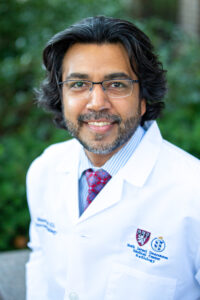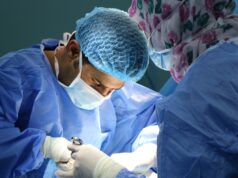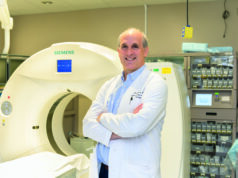
Muneeb Ahmed is an interventional radiologist specialising in interventional oncology (IO) at Beth Israel Deaconess Medical Centre (Boston, USA) and current president of the Society of Interventional Oncology (SIO). Speaking to Interventional News, Ahmed describes the nature of his appointment to date, his past clinical experiences which valuably inform his role, and what he hopes to achieve throughout his presidency.
IN: Please introduce yourself—what does your clinical practice look like?
I am currently the chief of interventional radiology (IR) at Beth Israel Deaconess Medical Center (BIDMC), professor of radiology at Harvard Medical School, and current president of SIO. Originally from Pakistan, I completed training in diagnostic radiology here at BIDMC, IR training at the Johns Hopkins Hospital, and have been a practicing attending IR physician at BIDMC since then. I lead a busy clinical IR practice, with 12 IR faculty and multiple residents every year at a large academic medical centre. My own clinical focus is on IO, including all forms of image-guided tumour ablation and transarterial therapies, and in the treatment of complex portal hypertension. In addition, I oversee a translational research laboratory where we study the effects of thermal ablation on tumour biology.
IN: Why did you want to become involved in the board of SIO? How did this come about?
The Society of Interventional Oncology annual scientific meeting (SIO; 25-29 January, 2024, Long Beach, USA)—formally known as the World Conference of Interventional Oncology (WCIO)—was developed more than 25 years ago out of a desire for the IO community to come together to discuss clinical practice, research and education. I originally became involved as a resident, presenting my research at WCIO and seeing leaders in the field who had similar interests in IO. As an attending interventional radiologist, I continued to volunteer—joining the annual meeting program committee, and ultimately, serving as program chair for the 2017 WCIO meeting.
As the WCIO progressed into the more formal SIO, I have continued to volunteer for larger roles, which has led to holding positions on the SIO board, such as treasurer, and now president. Throughout my 20+ years of involvement with the WCIO/SIO, the core values of the society—its commitment to advancing IO and how effective it has been in fostering research and education—have continued to impress me. My own positive experiences highlight the opportunity for all of us in the field to contribute and help advance IO, and the SIO has been a great place to do just that.
IN: You became president in January of this year—how has it been so far? What have you been working on?
Assuming the role of president of SIO is both very exciting and daunting at the same time. I have the privilege of continuing the work of many prior successful and well-known previous presidents, most recently Matt Callstrom (Mayo Clinic College of Medicine, Rochester, USA), our immediate past-president. It has been a very busy year already, as the SIO is working on many fronts to meet the needs of IO.
First up, we launched the SIO’s first clinical trial—the ‘Ablation with confimation of colorectal liver metastases’ (ACCLAIM) trial, which is a prospective international multicentre trial designed to demonstrate the importance of intraprocedural ablation margin confirmation. We just announced a new call for grant proposals in Y90 radioembolization and immunotherapy, sponsored by AstraZeneca. At the same time, we continue to build on our exciting IO master class educational programs, having successfully held our Y90 radioembolization master class in June, and another in-person musculoskeletal IO master class in the fall. On top of this, we are working on engaging with more members of the IO community by partnering with IR societies in Asia and Latin America. The SIO team and our group of volunteer physicians has been very active and I have been busy keeping track and making sure we are progressing on all of these fronts.
IN: Do you feel like there are aspects of your clinical practice that complement your position as president? How has your career as an IR thus far set you up for taking on this responsibility?
Definitely. Clinically, I have always had a strong focus on IO, including the introduction of new treatments at my institution, building a robust practice through tumour board participation, and developing novel multidisciplinary clinics at a large academic institution. In fact, our multidisciplinary liver tumour clinic is one of the most well-rounded and busiest growing practices within our own cancer centre. At the same time, we have an active IR training program, teaching residents how to practice evidence-based, comprehensive clinical IR.
Finally, I have always had a strong interest in translational research, leading a basic science and transitional animal lab with a focus on studying interventional oncology related tumour biology, and now strategies to augment IO induced immunotherapy. All of these experiences have provided me with a comprehensive perspective on the opportunities within the IO specialty, and what the day-to-day challenges are that practicing interventional oncologists face. This has really influenced my thoughts on where the society can help serve its membership and its broader patient and physician constituencies. My own experiences in working in every day with medical, radiation, and surgical oncologists to accommodate different perspectives and offer the best clinical care for each patient has also taught me the value of successful collaboration, which I bring to my work as SIO president in continuing to build out our own partnerships and relationships with many different collaborating organisations and individuals.
IN: What are your goals for the rest of your presidency?
It is an exciting time to be in IO and leading the SIO in particular. My overall goal is to leave the SIO better off at the end of my presidency than when I started. To this end, I want to continue to grow SIO as the strongest voice for the IO community, meeting the needs of physicians and our patients by advancing innovative research, providing the best possible educational programs and training, and advocating for IO inclusion in clinical practice guidelines. Ultimately, I would like to see the SIO build an even bigger tent, so that anyone doing IO will see the SIO as their home and community, just as I have all these years.










